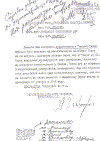
 Testimonial of Wendell Wilkie
Testimonial of Wendell Wilkie
Despite deep-seated mistrust and hostility between the Soviet Union and the Western democracies, Nazi Germany's invasion of the Soviet Union in June 1941 created an instant alliance between the Soviets and the two greatest powers in what the Soviet leaders had long called the "imperialist camp": Britain and the United States. Three months after the invasion, the United States extended assistance to the Soviet Union through its Lend-Lease Act of March 1941. Before September 1941, trade between the United States and the Soviet Union had been conducted primarily through the Soviet Buying Commission in the United States.
Lend-Lease was the most visible sign of wartime cooperation between the United States and the Soviet Union. About $11 billion in war material was sent to the Soviet Union under that program. Additional assistance came from U.S. Russian War Relief (a private, nonprofit organization) and the Red Cross. About seventy percent of the aid reached the Soviet Union via the Persian Gulf through Iran; the remainder went across the Pacific to Vladivostok and across the North Atlantic to Murmansk. Lend- Lease to the Soviet Union officially ended in September 1945. Joseph Stalin never revealed to his own people the full contributions of Lend-Lease to their country's survival, but he referred to the program at the 1945 Yalta Conference saying, "Lend-Lease is one of Franklin Roosevelt's most remarkable and vital achievements in the formation of the anti-Hitler alliance."
Lend-Lease material was welcomed by the Soviet Union, and President Roosevelt attached the highest priority to using it to keep the Soviet Union in the war against Germany. Nevertheless, the program did not prevent friction from developing between the Soviet Union and the other members of the anti-Hitler alliance. The Soviet Union was annoyed at what seemed to it to be a long delay by the allies in opening a "second front" of the Allied offensive against Germany. As the war in the east turned in favor of the Soviet Union, and despite the successful Allied landings in Normandy in 1944, the earlier friction intensified over irreconcilable differences about postwar aims within the anti-Axis coalition. Lend-Lease helped the Soviet Union push the Germans out of its territory and Eastern Europe, thus accelerating the end of the war. With Stalin's takeover of Eastern Europe, the wartime alliance ended, and the Cold War began.

World War II: American POWs and MIAs
The guns of distant battles fell silent long ago, but unanswered questions concerning United States servicemen missing in action and unrepatriated prisoners of war continue to concern the nation. Recently, the missing and prisoners of war from the Vietnam War have been the focus of attention.
But Soviet archival documents -- from an earlier era after World War II -- reveal that Americans were detained, and even perished, in the vast Soviet GULAG. To find out additional information about Americans liberated from German prison camps by the Red Army and then interned in Soviet camps, the U.S./Russian Joint Commission on POW/MIAs was formed early in 1992. Library of Congress officials, among others, have been authorized to research Russian archival materials on the subject in Moscow.
Through such efforts and additional cooperation, the fate of those missing in the Cold War may become known as well. Russian news reports tell of a United States B-29 aircraft shot down by Soviet interceptors over the Baltic Sea in April 1950. One of the Soviet pilots who downed the B-29 reported that the aircraft was recovered from the sea, but the fate of the crew is unknown.
The history of warfare cruelly suggests that some questions concerning the missing in action and prisoners of war will never be answered. Nevertheless, candor, goodwill, and a spirit of cooperation on all sides can minimize such questions. The opening of archives is a step forward in getting at the truth which can clear up the confusion and suspicion created in the past.

Please follow the guided tour or have a look at one of these showcases:
When you have seen them all, walk down the stairs, back to the entrance hall.